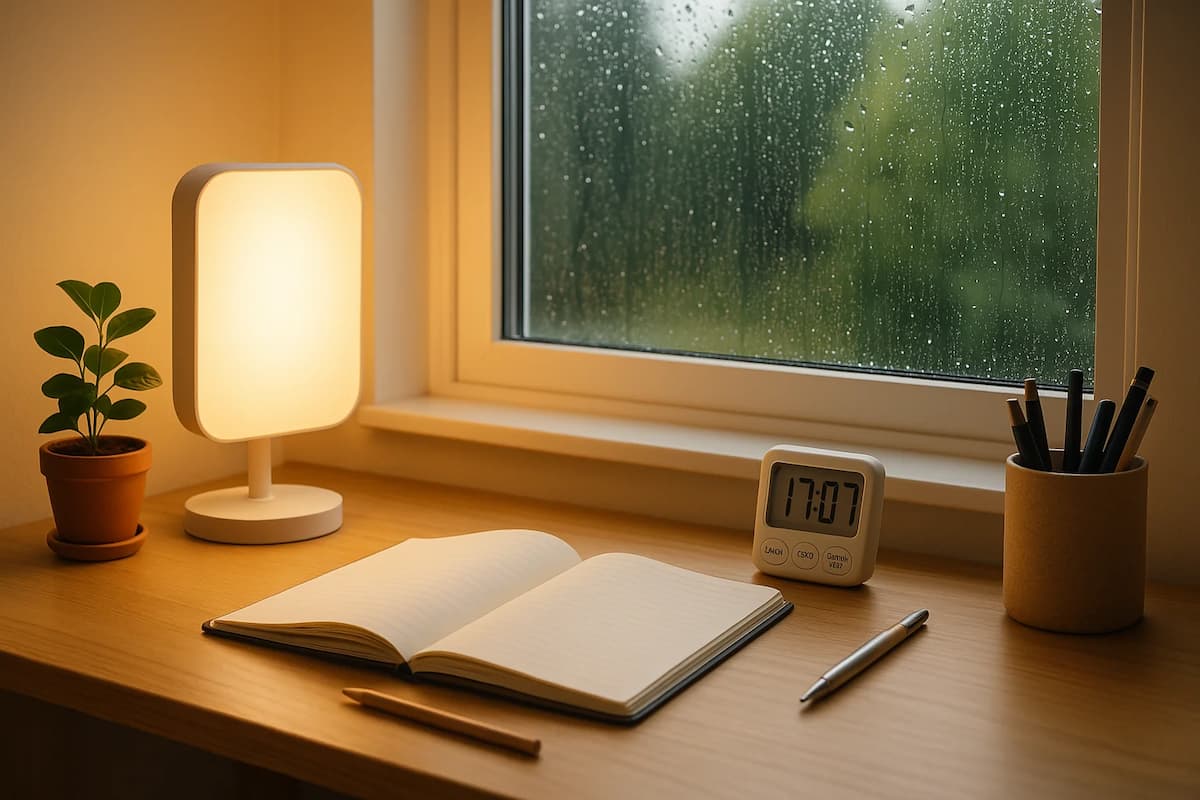
Watch short for this article (5 slides)
Transforming Gray Skies: Actionable Strategies for Productivity, Wellness, and Creativity on Rainy Days
The rhythmic drumming of rain against the window pane often signals a shift – a temptation to curl up and let the day drift by. While rest is valuable, rainy days present a unique, often underutilized, opportunity. The reduced pressure to be outdoors and the naturally subdued atmosphere can foster intense focus, deep relaxation, or bursts of creativity. Instead of succumbing to lethargy, let's explore highly specific, actionable strategies to intentionally leverage indoor time, tailored for maximizing productivity, nurturing well-being, and sparking creative exploration.

Photo by Dana Marin (Amsterdamian) on Unsplash
This isn't just about finding things to do; it's about understanding how to optimize your environment and mindset to make rainy days genuinely enriching, moving beyond generic advice to offer concrete techniques backed by context and purpose.
Section 1: Architecting a Productive Haven: Mastering Focus While Working or Studying Indoors
A rainy day can paradoxically boost concentration by minimizing the "fear of missing out" (FOMO) on outdoor activities and providing a consistent, soothing background soundscape. However, harnessing this potential requires deliberate environmental and mental adjustments.

Optimizing Your Sensory Environment
- Strategic Lighting: Counteract the gray gloom not just with any light, but with the right light. Aim for warm white light sources, ideally with adjustable brightness and a color temperature between 2700 K and 3000 K. This mimics the calming, cozy hues of late afternoon sun, rather than the harsh blue light of midday which can feel jarring on an overcast day. Position lamps to illuminate your workspace indirectly, reducing glare. Consider a SAD lamp (even if you don't have diagnosed Seasonal Affective Disorder) for a 20-30 minute morning session to help regulate your circadian rhythm and boost alertness, particularly on consecutively gloomy days. (Source: Harvard Health - Blue Light Effects)
- Curated Soundscapes: Leverage the rain or replace distractions strategically.
- Embrace the Rain: If the natural sound is soothing, allow it. Close unnecessary noisy apps or internal doors to isolate it.
- Mask Distractions: Use noise-masking apps or websites (e.g., myNoise, Noisli) offering specific sound frequencies. Try 'pink noise' (more balanced than white noise) or instrumental tracks specifically designed for focus (classical baroque, lo-fi hip hop, ambient electronic). Binaural beats (requiring headphones) claim to promote specific brainwave states (e.g., beta waves for focus), though scientific consensus varies. The key is consistency and lack of jarring changes or lyrics.
- Targeted Aromatherapy: While research is ongoing, certain scents are widely believed to influence mood and alertness via the olfactory system's direct link to the brain's limbic system. For focus, consider:
- Peppermint: Often associated with invigoration and mental clarity.
- Rosemary: Linked anecdotally and in some small studies to improved memory and concentration.
- Citrus (Lemon, Orange): Generally perceived as uplifting and energizing.
Advanced Time Management Techniques

- The Pomodoro Technique (Detailed): Work in focused bursts, typically 25 minutes, followed by a strict 5-minute break. Crucially, completely step away from the task during the break (stretch, get water, look out the window). After four "Pomodoros," take a longer break (15-30 minutes). Use a dedicated timer. Why it works: Creates manageable work blocks, combats mental fatigue, instills a sense of urgency, and makes large tasks less daunting. (Source: Francesco Cirillo - Official Pomodoro Technique)
- Time Blocking: Allocate specific blocks of time in your calendar for specific tasks or types of work (e.g., 9:00-10:30 AM: Report Writing; 10:30-11:00 AM: Email Processing). Why it works: Provides clear structure, prevents multitasking drift, ensures dedicated time for priorities.
- "Eat The Frog": Identify your most important, often most challenging, task for the day (the "frog") and commit to tackling it first thing before less critical activities. Why it works: Leverages peak morning energy and focus for high-impact work, creating momentum for the rest of the day. (Concept popularized by Brian Tracy).
Adapting to Your Natural Work Style
Instead of rigid personality labels, consider your needs:
- If You Thrive on Structure: Embrace Time Blocking meticulously. Use a detailed to-do list with estimated times. Set clear start and end points for your workday. The rainy day provides fewer external disruptions to derail your plan.
- If You Need Flexibility & Variety: Use the Pomodoro technique but allow breaks for short, unrelated activities (e.g., 5 minutes of doodling, tidying a small area, brief mindful breathing). Alternate between different types of tasks (analytical, creative, administrative) to maintain engagement. The key is intentional shifts, not aimless drifting.
Section 2: Intentional Self-Care: Deep Rejuvenation Rituals for Mind and Body
Rainy days offer a societal permission slip for introspection and rest. Frame self-care not as mere indulgence, but as a vital investment in your mental, physical, and emotional resilience.
Mindful Morning Activation (Beyond Just Stretching)

Photo by Shashi Chaturvedula on Unsplash
- Targeted Gentle Movement: Instead of vigorous exercise, focus on mindful mobility. Try 15-20 minutes of:
- Yin Yoga: Holding passive stretches for longer periods (3-5 minutes) to target deep connective tissues. Focuses on hips, pelvis, inner thighs, spine.
- Restorative Yoga: Using props (pillows, blankets) to fully support the body in gentle poses, promoting deep relaxation.
- Specific Stretches: Gentle neck rolls (ear to shoulder), cat-cow poses (arching and rounding the spine), thread-the-needle (shoulder opening). Why: Improves circulation, eases stiffness without over-exertion, connects mind and body.
- Hydration Ritual: Start with a glass of warm water. Adding lemon is popular; while claims of major "detox" effects are debated, it adds flavor and Vitamin C. The primary benefit is starting your day hydrated, which is crucial for cognitive function and energy levels. Why: Aids digestion, supports cellular function, combats potential dehydration-induced fatigue.
- Purposeful Journaling (5-10 Minutes): Go beyond random thoughts. Try:
- Gratitude Listing: Specifically list 3-5 detailed things you are grateful for and why.
- Intention Setting: Write down one key intention for your day (e.g., "approach tasks with patience," "find joy in small moments").
- Brain Dump: Write continuously for 5 minutes, releasing any worries or mental clutter onto the page without judgment. Why: Clears the mind, promotes positive focus, reduces anxiety.
Midday Mindfulness & Sensory Reset

Photo by Anita Austvika on Unsplash
- DIY Spa Elements (Simple & Effective):
- Warm Bath Enhancement: Add 1-2 cups of Epsom salts (magnesium sulfate) to help relax muscles. A few drops of calming essential oil like lavender or chamomile can enhance the experience. Keep water comfortably warm, not scalding (around 98-102°F or 37-39°C). Soak for 15-20 minutes.
- Quick Face Mask: Use a simple DIY mask (e.g., oatmeal mixed with water or honey for soothing hydration) or a favorite sheet mask. Leave on for 10-15 minutes.
- Elevated Tea Time: Choose teas associated with desired effects:
- Calming: Chamomile, Lavender, Passionflower.
- Gentle Focus/Alertness: Green Tea (contains L-theanine, which can promote relaxed alertness).
- Digestive Comfort: Peppermint, Ginger.
- Guided Mindfulness Practice (10-15 Minutes): Use apps like Calm, Headspace, Insight Timer, or find guided meditations on YouTube focusing on:
- Body Scan Meditation: Bringing awareness sequentially to different parts of the body.
- Loving-Kindness Meditation: Cultivating feelings of warmth and compassion for self and others.
- Mindful Breathing: Focusing solely on the sensation of the breath entering and leaving the body. Why: Proven stress reduction technique, improves emotional regulation, enhances self-awareness. (Source: American Psychological Association - Mindfulness)
Conscious Evening Wind-Down for Restful Sleep
- Immersive Reading (Beyond Scrolling): Choose a physical book or e-reader (with blue light filter enabled). Select engaging fiction, calming poetry, or thought-provoking non-fiction rather than stimulating news or work-related material.
- Strict Digital Detox: Power down all screens (phones, tablets, computers, TV) at least 60-90 minutes before your intended bedtime. Why: The blue light emitted suppresses melatonin production, the hormone essential for regulating sleep-wake cycles. Engaging content can also keep the mind overly active. (Source: Sleep Foundation - Electronics & Sleep)
- Reflective Gratitude Practice: Before sleep, mentally review or write down three specific positive moments or things from your day, focusing on the feeling they generated. Why: Reinforces positive neural pathways, shifts focus away from worries, promotes contentment conducive to sleep.
Section 3: Igniting Inner Sparks: Engaging Hobbies Tailored for Indoor Exploration
Use the contained energy of a rainy day to dive into activities that feed your curiosity, creativity, or desire to build tangible skills.

For the Aesthetically & Artistically Inclined
- Expressive Painting/Drawing: Don't just doodle – try a specific technique. Experiment with watercolor washes to capture the moodiness of the rain, attempt acrylic pouring for abstract expression, or focus on detailed botanical illustration of houseplants.
- Observational Photography: Use the unique lighting challenges. Focus on macro photography of raindrops on windows or leaves, capture moody interior portraits using window light as your key source, or experiment with long exposures of streetlights reflecting on wet pavement (from a covered viewpoint).
- Focused Writing Projects: Move beyond aimless journaling. Start a short story using the rain as a key plot element, write a series of Haiku capturing different aspects of the day, or dedicate an hour to outlining that novel idea you've postponed.
For the Analytical & Ever-Curious Mind
- Targeted Online Learning: Instead of browsing randomly, commit to completing one module of a course on platforms like Coursera, edX, Khan Academy (free resources), MasterClass (expert-led), or Skillshare (creative skills). Choose a specific topic: introductory Python coding, the science of well-being, a historical period, a specific cooking technique.
- Complex Puzzles & Brain Games: Engage deeper cognitive functions. Attempt a challenging jigsaw puzzle (1000+ pieces), learn Sudoku strategies beyond the basics, tackle cryptic crosswords, or explore logic puzzle apps/websites (e.g., Brilliant.org).
- Themed Documentary Deep Dive: Select a specific subject (e.g., deep-sea exploration, ancient civilizations, particle physics) and watch 1-2 high-quality documentaries on platforms like CuriosityStream, Netflix, HBO Max, PBS documentaries, or Kanopy (often free through libraries). Take notes on surprising facts or new questions raised.
For the Hands-On Tactile Creator
- Skill-Building Crafts: Choose a project with a defined outcome. Learn basic origami folds to create specific animals, try beginner calligraphy with a starter kit, make DIY beeswax wraps (eco-friendly alternative to plastic wrap), or attempt knitting/crocheting a simple pattern like a scarf or dishcloth using online tutorials (e.g., Ravelry, YouTube).
- Nurturing Indoor Greenery: Go beyond basic watering. Research the specific needs of your houseplants (light, humidity, soil type) and repot any that are root-bound. Start an indoor herb garden kit (basil, mint, chives are often easy) or propagate existing plants (e.g., spider plants, pothos) in water.
- Ambitious Baking Projects: Challenge yourself beyond cookies. Attempt making a sourdough starter from scratch (a multi-day project!), master delicate macarons, try baking artisanal bread requiring specific kneading/proofing techniques, or perfect a complex layer cake recipe.
Conclusion: Embracing the Potential Within Rainy Days
Rainy days need not equate to lost time or listless boredom. By intentionally shaping our environment, choosing activities aligned with our needs – whether for focused work, deep restoration, or creative expression – and applying specific, thoughtful techniques, we can transform these gray days into surprisingly productive and fulfilling experiences. The key lies in shifting from passive reaction to proactive engagement.
Which specific strategy or activity resonates most with you for your next rainy day? Consider what you truly need – focus, rest, or creative stimulation – and choose accordingly. The opportunity is yours to seize.